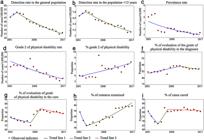| Detection rate of new leprosy cases in the general population/100,000 inhabitants. |
Measure the strength of the endemic morbidity, magnitude, and tendency. |
Hyperendemic: ≥40.0/100,000 inhab. |
| Very high: 20.00-39.99/100,000 inhab. |
| High: 10.00-19.99/100,000 inhab. |
| Medium: 2.00-9.99/100,000 inhab. |
| Low: <2.00/100,000 inhab. |
| Detection rate of new leprosy cases in persons under 15 years/100,000 inhabitants. |
Measure the strength of the recent transmission of the endemic and its tendency. |
Hyperendemic: ≥10.00/100,000 inhab. |
| Very high: 5.00-9.99/100,000 inhab. |
| High 2.50-4.99/100,000 inhab. |
| Medium: 0.50-2.49/100,000 inhab. |
| Low: <0.5/100,000 inhab. |
| Annual leprosy prevalence rate/10,000 inhabitants. |
Measure the magnitude of the endemic. |
Hyperendemic: ≥20.0/10,000 inhab. |
| Very high: 10.0-19.9/10,000 inhab. |
| High 5.0-9.9/10,000 inhab. |
| Medium: 1.0-4.9/10,000 inhab. |
| Low: <1.0/10,000 inhab. |
| Rate of new leprosy cases with grade 2 physical disability at the time of diagnosis/1 million inhabitants |
Assess the deformities caused by leprosy in the general population and compare them with other disabling diseases. |
The tendency to reduce the detection rate, accompanied by a reduction in this indicator, characterizes a reduction in the magnitude of the endemic disease. |
| Proportion of leprosy cases with grade 2 physical disability at the time of diagnosis among the new cases detected and evaluated in the year. |
Evaluate the effectiveness of timely and/or early case detection activities. |
High: ≥10%. |
| Medium: 5%-9.9%. |
| Low: <5%. |
| Proportion of new leprosy cases with any degree of physical disability assessed at diagnosis. |
Measure the quality of care in health services. |
Good: ≥90%. |
| Fair: ≥75%-89.9%. |
| Poor: <75%. |
| Proportion of new leprosy cases with any degree of physical disability assessed at the time of cure. |
Measure the quality of care in health services. |
Good: ≥90%. |
| Fair: ≥75%-89.9%. |
| Poor: <75%. |
| Proportion of examined contacts of new leprosy cases diagnosed in the years of the cohorts. |
Measure the services' capacity to carry out surveillance of contacts of new cases of leprosy, increasing the timely detection of new cases. |
Good: ≥90.0%. |
| Fair: ≥75.0%-89.9%. |
| Poor: <75.0%. |
| Proportion of leprosy cure among new cases diagnosed in the years of the cohorts. |
Assess the quality of care and follow-up of newly diagnosed cases until treatment is complete. |
Good: ≥90%. |
| Fair: ≥75%-89.9%. |
| Poor: <75%. |

 Thumbnail
Thumbnail
